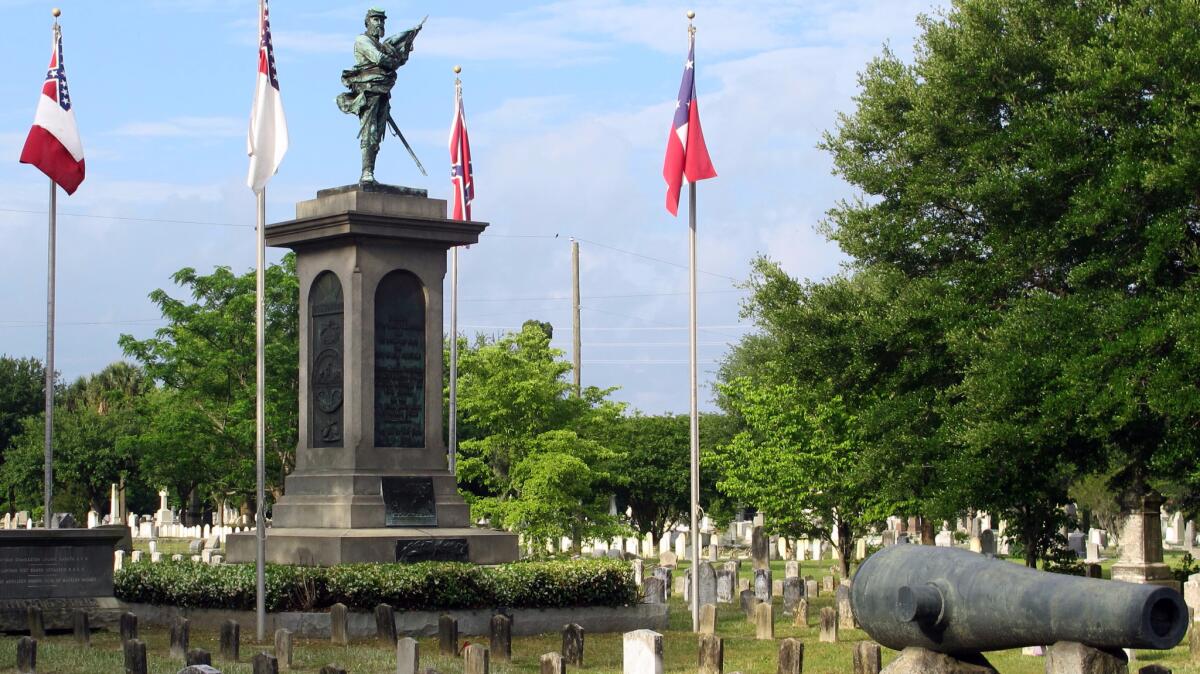Editorial: Confederate flags have no place flying over national cemeteries

- Share via
On Dec. 20, 1860, a convention called by the governor and legislature of South Carolina voted unanimously to secede from the United States of America, setting in motion the events that led to the shelling of Ft. Sumter the following April, and the onset of the Civil War. That brutal and bitter conflict was, at its heart, about the South’s insistence on maintaining the institution of slavery.
As students of Southern history will tell you, no single flag represented the Confederacy. The Confederate States of America adopted three successive designs before the war ended, and those were different still from the flags that Rebel troops carried into battle to separate friend from foe. But the most lasting of those banners is known as the “Southern cross,” the familiar diagonally crossed blue lines adorned with white stars and set against a red background. That flag picked up fresh currency in the 1950s among opponents of the civil rights movement. Today, it remains a potent symbol of white supremacy, racial intolerance and oppression.
Yet the U.S. Department of Veterans Affairs continues to fly it over some national cemeteries on Memorial Day and on Confederate recognition days, the latter celebrated under different names on four different days by eight different Southern states.
That practice is insupportable and an amendment to a congressional spending bill now moving through Congress would end it. The Republican-dominated House is to be commended for approving the measure even though a majority of Republicans voted against it. The ban should remain in the bill as it passes through the Senate, where it should be approved, and then it should be sent on to President Obama for his signature.
The U.S. government should not be flying the flag of the secessionists whose traitorous actions more than 150 years ago posed the most serious threat to the nation’s existence. But notably, the bill would not bar individuals from decorating their ancestors’ graves with small Confederate flags on the commemoration days. That’s an objectionable practice, but it is a matter of free speech, protected by the 1st Amendment.
No region of the United States has a morally pure history. By the time the U.S. Constitution was ratified in 1788, six of the 13 original states had ended slavery within their borders. As admirable as that might have been, it also means the states had previously allowed, and profited from, the practice. And Northern states have their own legacies of racism and segregation, which in truth have been a stain on this nation from the first European encounters with Native Americans and which continued long after slavery was abolished nationwide.
But the most sharply drawn sin was going to war to defend an economic system built on the subjugation of another race in the belief that it was inferior to whites. There’s a reasonable argument to be made that historical leaders should be measured against the norms of their times, and not retroactively condemned by a later standard they couldn’t imagine. But kidnapping, buying and selling human beings as chattel – and beating, raping and murdering them along the way – are moral transgressions no matter the era.
Flags are symbols, and the Stars and Stripes reflects the stitching together of disparate states into a whole. It is the banner under which millions of people have served and fought to defend the concept of the United States and the values it seeks to uphold.
The Confederate soldiers, even those who also fought in service of the United States, opted during those four bloody years to fight against the United States. White Southerners may see the flag as a symbol of Southern heritage, but for African Americans and others it is a fluttering reminder of one of the lowest moments in this country’s history.
Follow the Opinion section on Twitter @latimesopinion and Facebook
A cure for the common opinion
Get thought-provoking perspectives with our weekly newsletter.
You may occasionally receive promotional content from the Los Angeles Times.






